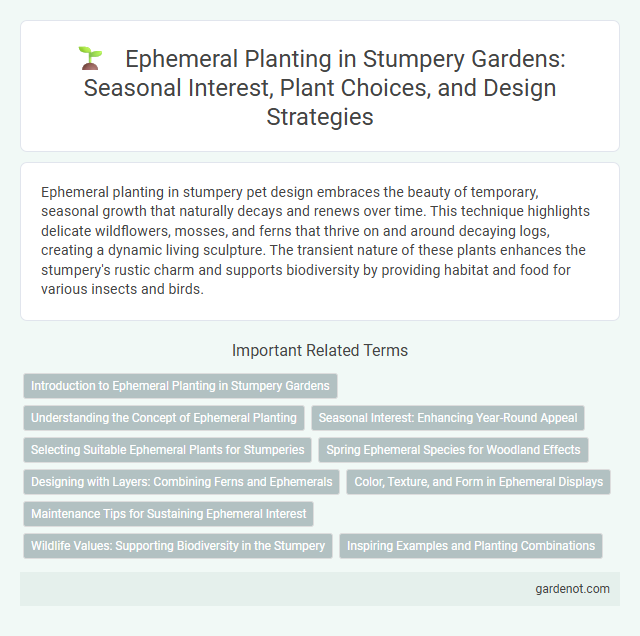Ephemeral planting in stumpery pet design embraces the beauty of temporary, seasonal growth that naturally decays and renews over time. This technique highlights delicate wildflowers, mosses, and ferns that thrive on and around decaying logs, creating a dynamic living sculpture. The transient nature of these plants enhances the stumpery's rustic charm and supports biodiversity by providing habitat and food for various insects and birds.
Introduction to Ephemeral Planting in Stumpery Gardens
Ephemeral planting in stumpery gardens emphasizes seasonal plants with short life cycles that thrive among decayed wood and natural debris, creating dynamic and evolving displays. This approach enhances biodiversity by supporting native flora and microhabitats, offering a habitat for insects and mosses that flourish in shaded, moisture-retentive environments. Integrating ephemeral species like spring bulbs, ferns, and woodland wildflowers revitalizes stumperies with bursts of color and texture that change throughout the year.
Understanding the Concept of Ephemeral Planting
Ephemeral planting involves cultivating plants with short life cycles that thrive in transient environments, emphasizing seasonal changes and natural rhythms. This approach enhances stumperies by incorporating dynamic botanical elements that transform the space throughout the year. Understanding ephemeral planting allows gardeners to create visually engaging, sustainable displays that align with ecological processes.
Seasonal Interest: Enhancing Year-Round Appeal
Ephemeral planting in stumperies maximizes seasonal interest by utilizing plants with varied bloom times, foliage colors, and textures that evolve throughout the year. Incorporating bulbs like snowdrops and crocuses in early spring, ferns and hostas in summer, and deciduous perennials displaying rich autumn hues ensures continuous visual appeal. This dynamic approach leverages temporary plantings to transform decaying wood features into vibrant, ever-changing garden focal points.
Selecting Suitable Ephemeral Plants for Stumperies
Selecting suitable ephemeral plants for stumperies involves choosing species that thrive in shaded, moist environments and complement the natural decay of wood. Ferns like Polypodium vulgare, woodland bulbs such as bluebells (Hyacinthoides non-scripta), and spring ephemerals like Trillium are ideal for creating dynamic seasonal interest. These plants provide delicate textures and rapid growth cycles, enhancing the stumpery's naturalistic and woodland garden aesthetic.
Spring Ephemeral Species for Woodland Effects
Spring ephemeral species such as trilliums, bloodroot, and Dutchman's breeches thrive in stumperies by taking advantage of the early spring light before woodland canopies fully develop. These plants complete their life cycle rapidly, emerging in late winter to early spring and retreating by early summer, creating dynamic seasonal interest and supporting woodland biodiversity. Incorporating these ephemeral species enhances the natural woodland effect while promoting habitat for pollinators and woodland fauna.
Designing with Layers: Combining Ferns and Ephemerals
Designing with layers in a stumpery enhances visual interest by combining the lush texture of ferns with the delicate presence of ephemerals. Ferns provide a stable, structured backdrop while ephemeral plants introduce seasonal bursts of color and unique foliage that thrive in shaded, moist environments. This layered approach maximizes biodiversity and creates dynamic, ever-changing garden compositions ideal for woodland landscapes.
Color, Texture, and Form in Ephemeral Displays
Ephemeral planting in stumperies emphasizes vibrant color contrasts, rich textures, and sculptural forms to create striking seasonal displays. Utilizing a variety of foliage and flower types enhances the visual complexity and depth, capturing the transient beauty of each growth phase. These dynamic combinations highlight the natural interplay of light and shadow, transforming decomposing wood into living art.
Maintenance Tips for Sustaining Ephemeral Interest
Ephemeral planting thrives on seasonal bursts of color and texture, requiring targeted maintenance to sustain interest. Regular deadheading and timely removal of spent blooms prevent unsightly decay and encourage prolonged flowering cycles, while monitoring soil moisture ensures delicate ephemeral species do not suffer drought stress. Implementing light pruning and replenishing nutrient-rich mulch supports healthy regrowth and enhances the dynamic aesthetic of a stumpery garden throughout fleeting growth periods.
Wildlife Values: Supporting Biodiversity in the Stumpery
Ephemeral planting in a stumpery enhances wildlife by providing seasonal habitats that support diverse insect populations, including pollinators and decomposers crucial for ecosystem function. The temporary nature of these plants allows for a dynamic range of flora, fostering increased biodiversity through different flowering periods and foliage structures. This diversity contributes to a balanced local ecosystem by offering food sources and shelter for various birds, amphibians, and invertebrates throughout the year.
Inspiring Examples and Planting Combinations
Ephemeral planting in stumperies showcases seasonal bursts of color and texture, with ferns, mosses, and shade-loving bulbs like snowdrops and bluebells creating dynamic, short-lived displays. Combining creeping groundcovers such as ajuga or native wildflowers with decaying wood enhances biodiversity and visual interest over brief periods. Inspiring examples include layering ephemeral spring ephemerals under mature tree stumps to mimic natural forest floors, fostering habitats while delighting with transient beauty.
Ephemeral planting Infographic

 gardenot.com
gardenot.com